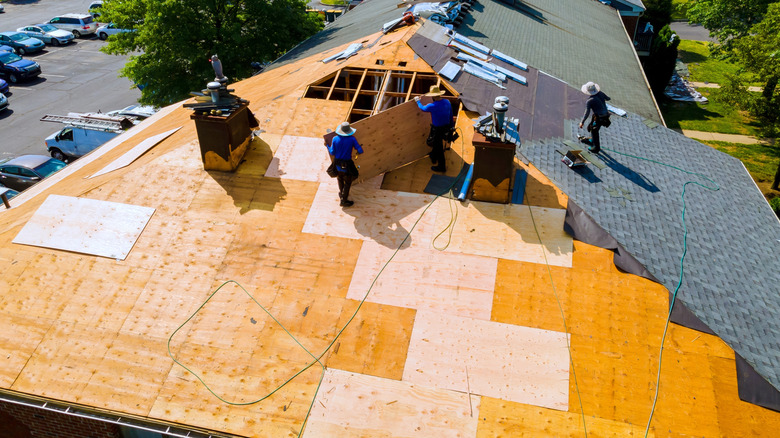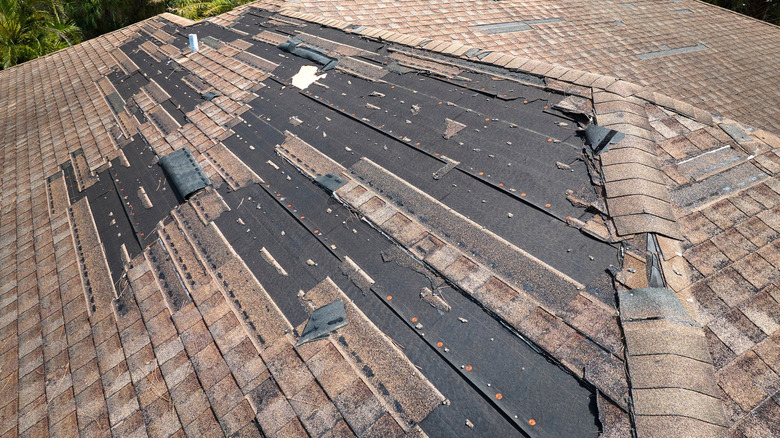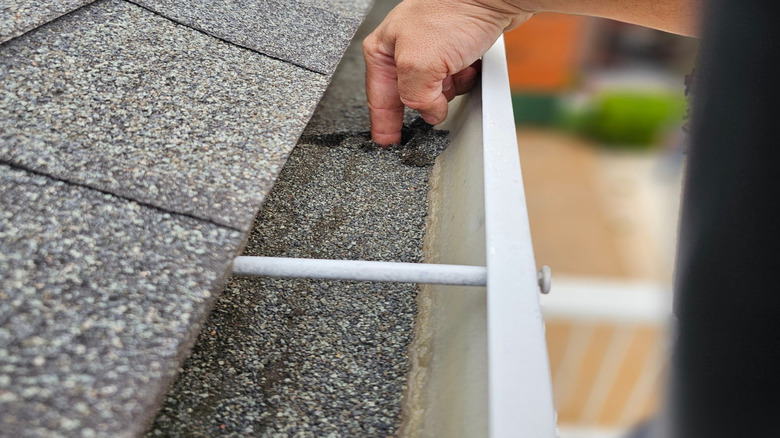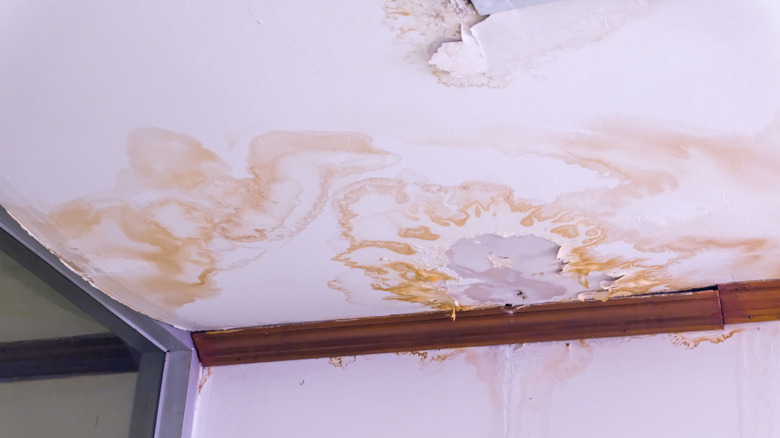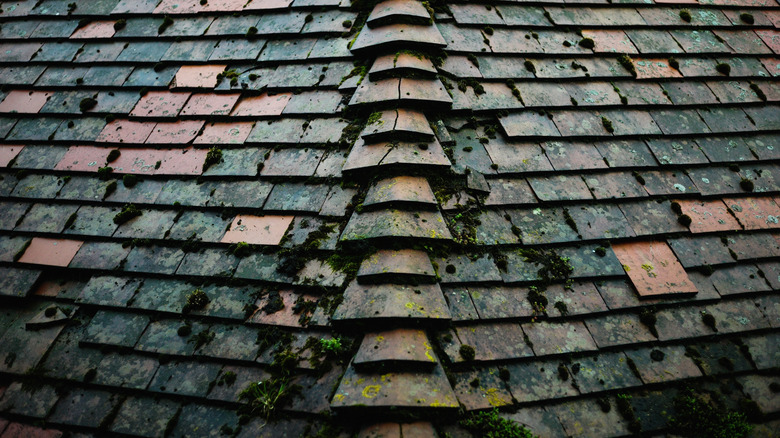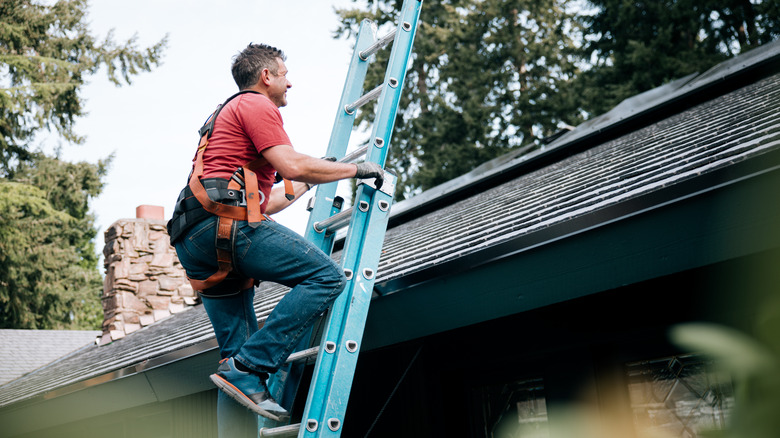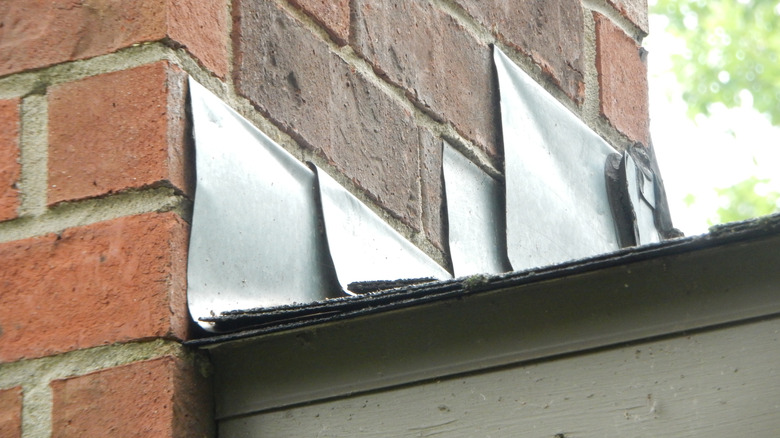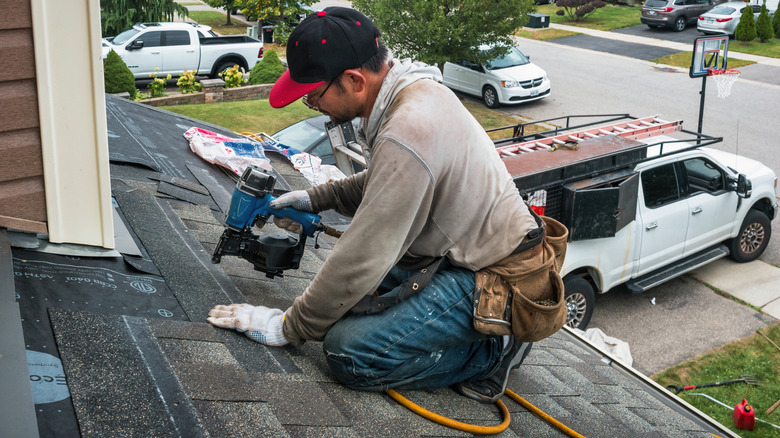12 Signs Your Roof Needs Replacing ASAP
We may receive a commission on purchases made from links.
Your roof won't last forever, and when it starts to fail, the signs aren't always obvious. Some indicators that it's time for a replacement are straightforward, like a roof that's more than 20 years old. Others show up as subtle warning signs: a small leak, curling shingles, or water stains on your ceiling. No matter how they appear, they all point to the same solution: Eventually, your roof will need to be replaced.
That's why spotting the issue can take different forms: sometimes you'll see it from the street, and other times it's hidden beneath the surface. In a few cases, you might get by with replacing only a section of your roof or making minor repairs, but that only buys time. The longer you wait, the more extensive (and expensive) the damage becomes. Here are the clearest signs your roof needs to be replaced as soon as possible. There are, of course, common and expensive mistakes to avoid at all costs when replacing your roof, but these are the signs to know before starting the process.
There are many missing or broken shingles
Missing, curling, or cracking shingles is one of the clearest signs that your roof's protective layer is starting to fail. While a few damaged shingles don't always mean you have to replace your entire roof ASAP, they do still warrant immediate attention so it doesn't get worse — that is, infinitely more expensive to deal with. In some cases, a simple patch or shingle replacement can buy you time, but that's only effective if the rest of your roof is still in good shape. If the rest of your roof isn't doing well, either, then patching over brittle shingles is only a temporary fix. This is a mistake everyone makes when getting a new roof. You could end up spending more on repeated repairs than on one proper replacement.
When widespread damage appears, like after a big storm, it's best to call a licensed roofer for an inspection. They can tell you whether a full replacement is the smarter long-term solution. Acting early like this can prevent mold and leaks that can quickly become much more expensive problems. It's also smart to document what you see before repairs begin. Take photos of the missing or damaged shingles, and keep a note of when the issues started. This information can help with warranty claims or insurance coverage if the roof's condition worsens.
You find a lot of granules in the gutters
If you've been keeping your gutters unclogged and clear of falling leaves, but then notice coarse, sand-like material collecting there, those are shingle granules. They're the tiny, gritty coating that gives asphalt shingles their color and texture. They also protect your roof from UV rays and other types of weathering. Over time, it's normal for a few granules to wash off, especially after a storm or as the roof ages. A small amount coming from one section of the roof doesn't mean you need a whole new roof. However, if you start seeing handfuls of granules, or notice that your shingles are starting to look "bald" in large patches, that's a sign the protective layer is wearing away in a more serious way.
Once granules are gone, the asphalt underneath is exposed, leaving your roof more vulnerable to the elements. So, if this is happening across multiple areas (and you've noticed a few other signs on this list, like curling shingles or water stains inside), then it's likely time to consider replacement. A professional roofer can confirm whether a repair is sufficient or if your roof is nearing the end of its life. Catching it early can prevent costly water damage and extend your home's structural lifespan.
Your roof deck is sagging
If you notice your roofline starting to bow inward, or the decking looks uneven when viewed from the street, it's time to act immediately. A sagging roof is one of the clearest signs that your roof needs attention ASAP. Unlike missing shingles or surface wear, a dip in your roofline points to a deeper structural issue. Sagging can be caused by trapped moisture that's weakened the decking, rotted framing, or even overloaded support beams. In some cases, it's the result of long-term water infiltration that's gone unnoticed beneath the shingles. But whatever the cause, it's a structural red flag that can't wait.
If you can't see any sagging from the outside, check the attic for visible sagging between rafters, cracked beams, or damp insulation. These are signs the structure is losing integrity. In cold climates, the weight of snow and ice can make matters worse, putting extra stress on already weakened areas and risking a full or partial collapse. This is not an issue to monitor over time. It's one to fix right away. Contact a licensed roofer or structural engineer for an emergency inspection. They can determine whether the damage is limited to the roof deck or if deeper repairs are needed to restore the frame's stability and prevent catastrophic failure.
There is daylight visible through the attic
If you can see sunlight streaming through your attic boards, water can and eventually will find its way through them, too. That said, make sure the light is actually coming from the roof itself. Sometimes, sunlight enters through vents, ridge caps, or even the eaves, which is completely normal and nothing to worry about. However, be sure these gaps aren't too big, or if they are, they are covered with mesh. This is one of the keys of humane pest prevention and removal, as critters can use those bigger daylight-causing gaps to get inside.
If the light is coming through a small gap around flashing, a chimney, or a vent pipe, a localized repair should take care of it. But if you notice light seeping through multiple spots in the decking or along roof seams, that's a much bigger red flag. It often means the wood beneath your shingles has begun to rot or deteriorate, an issue that usually calls for a full roof replacement. In any case, it's best to have a professional inspect it right away before small openings turn into serious leaks or structural damage.
You can see water stains on your ceiling
Brown or yellowish water stains on your ceiling are never a good sign, but they don't always mean your entire roof is failing. However, in many cases they're still the first visible clue that moisture is finding its way into your home in places it's not supposed to be — so don't ignore them. Water always travels, so the spot you see on your ceiling might not be directly below the source of the problem. And, it's not always from damaged shingles. Sometimes it could be damaged flashing or even an interior plumbing issue.
To find the source, start by checking your attic for damp insulation, wet spots on rafters, or visible drips during rain. If the staining appears near a chimney, skylight, or vent, the culprit might be deteriorated flashing or failed sealant rather than the shingles themselves. However, if the stains keep spreading or you notice multiple affected areas, it could indicate widespread roof deterioration or aging materials that can't keep out water properly anymore. Even if the damage seems minor, get a professional inspection as soon as possible. Finding out whether the water is coming from a plumbing line, condensation, or your actual roof can save you thousands in unnecessary repairs and help you address the real issue before mold or structural damage sets in.
Moss or mold is growing abundantly on the shingles
A little moss or algae on your roof doesn't always mean trouble. It's often just cosmetic and can be cleaned off safely. However, when moss starts growing thickly or spreading across large sections of your shingles, it can trap moisture against the roof's surface. Over time, that moisture can cause the shingles to lift, crack, and rot, leading to leaks and premature roof failure! Mold growth can also signal that moisture has already penetrated deeper layers of your roofing system, which warrants a closer look.
If the growth is light, you can gently clean it yourself using a soft-bristle brush and a mixture of water and mild detergent. You can also use a specialized roof cleaner, like 30 SECONDS Mold and Mildew Stain Remover Concentrate, which you can just spray on and leave. However, one of the mistakes everyone makes when pressure washing is attempting to use the appliance on their roof. It's too intense can strip away granules and shorten your roof's lifespan. After cleaning, check for soft spots, warped shingles, or signs of lingering dampness. If the moss comes back quickly or you see structural damage while you're up there cleaning, it's a good idea to have a professional look at your roof to decide if it needs fixing or replacing.
It feels soft or spongy in spots when you are walking on the roof
If parts of your roof feel soft or unstable underfoot, that's a major warning sign. It usually means the plywood decking beneath the shingles has been weakened by trapped moisture or rot. Even if the shingles above look fine, a soft spot indicates water has seeped underneath. This is something a simple patch job won't be able to fix.
Yet we know that most homeowners don't spend much time just walking around on their roof. Because of this, you'll likely only discover the issue when you're up there for something else, like trimming overhanging branches or inspecting damage after a storm. So each time another chore calls for a trip to the roof, pay attention to how it feels beneath your feet. Solid roofing should feel firm and secure. If it gives or bends slightly when you step on it, that's a sign the underlying structure is deteriorating. In that case, it's best to get off the roof immediately and call a professional. A roofer can identify how far the damage extends and whether you'll need partial decking replacement or a full roof overhaul to restore the roof's safety.
There are persistent ice dams in winter
If you regularly see thick ridges of ice forming along your roof's edges in winter, that's a red flag. These are called ice dams, and while they might look harmless, they're actually a big sign that your roof and attic aren't working together as they should. Ice dams usually form when warm air from inside your home escapes through the attic and melts the snow sitting on your roof. The melted water flows down toward the colder roof edge, refreezes, and creates a barrier of ice. As this cycle repeats, more water backs up behind the dam and can seep under your shingles, causing leaks, rot, and plenty of insulation damage as a result.
Persistent ice dams often point to poor attic ventilation or insufficient insulation issues that become more common as roofs age or materials degrade. The longer the problem continues, the more strain it puts on your roof's structure and gutters. If you're dealing with ice dams every winter, have a professional come out to inspect your roof and attic together. They can check for damaged underlayment, blocked vents, or areas where warm air is escaping. Fixing ventilation and insulation problems can sometimes extend your roof's life, but if the ice has already caused warping or rot, a full roof replacement may be the safest long-term solution.
You have active roof leaks
Rainy days are tough enough, so what happens when you have water dripping into your home every time it pours? One active leak is already annoying, but could just point to a singular weak spot. However, when your roof has multiple leaks, it's a major warning sign that its overall integrity is failing. Patching the same spot over and over might seem like a quick fix, but each repair is only a band-aid on a much bigger problem. Repeated leaks weaken the roofing materials underneath, cause water to seep into the decking, and can lead to mold, rot, and structural damage.
Your roof is designed to protect your home, not to be patched endlessly. If rainwater is finding more than one way inside, it's time to stop the cycle of temporary fixes and consider a proper roof replacement. Addressing the problem now prevents small leaks from turning into costly, long-term damage. Track where leaks appear and note when they happen. This information helps a roofing professional pinpoint the most damaged areas, ensuring that you have a thorough assessment and replacement plan.
You have a sudden spike in your energy bills
A sudden increase in your heating or cooling costs could mean your roof isn't insulating your home in the way that it should. When roofing materials start to fail, whether it's due to worn-out shingles, damaged underlayment, or even inadequate ventilation, your attic can trap hot air in summer and lose warmth in winter. As your HVAC system works harder to maintain a comfortable temperature, your energy bills skyrocket. It's an often-overlooked sign that your roof's protective system is breaking down. Especially if you're seeing heat loss in the winter and heat gain in the summer, it may be time to replace your roof.
If you suspect your roof is the culprit, start by inspecting your attic. Look for uneven insulation, damp spots, or areas where daylight or drafts are coming through. Check that your attic vents are clear and functioning properly, since poor ventilation can worsen temperature swings and moisture buildup. If everything inside seems normal, but your bills keep climbing, it may be time to have a roofer evaluate your shingles and underlayment. Of course, there can also be other reasons for this! For example, higher energy bills are an indication that your HVAC itself might be in trouble, according to HGTV star Mike Holmes.
The flashing is rusty or otherwise deteriorating
Flashing is the name for the metal strips you put around chimneys, vents, and skylights. It acts as a sort of seal on the creases and is one of your roof's first lines of defense against water. If it's rusty, or if it cracks or pulls away from the roof too much, leaks are almost inevitable because of the gaps caused. There are lots of things that can cause flashing to fail: exposure to the elements over time, poor installation, or even roof movement from house settling or high winds.
The good news is that flashing can often be replaced on its own, which is a relatively small repair compared to replacing an entire roof. The catch is the timing. If the flashing has been neglected for a while, water may have already seeped under the shingles, leading to damage to the roof deck. In these cases, what starts as a simple flashing repair could escalate into a full roof replacement. To avoid this, inspect flashing regularly, especially after storms, and address any rust or gaps promptly. Early action can save you thousands and prevent small issues from becoming major problems!
Your roof is more than 20 years old
Most asphalt shingle roofs, one of the most common roofing materials, are built to last about 20 to 25 years. Once your roof reaches that age, even if it still looks "okay," it's time to start planning a replacement. This is because aging shingles tend to become brittle, lose granules, and are far more likely to fail during heavy rain or high wind. Waiting until visible damage appears can turn a manageable project into an emergency repair, often at a much higher cost. The average cost is now roughly $11,000, but can be much higher if you also need to make repairs, or have it as a rush job.
So, start budgeting and scheduling a professional inspection once your roof approaches the 20-year mark. Regular inspections can also catch small issues like loose flashing or minor leaks before they become costly problems, extending the life of your existing roof. Even if you don't plan to replace the roof for years to come, early planning gives you time to compare options, choose quality materials, and avoid last-minute stress protecting your home and your wallet in the long run.
